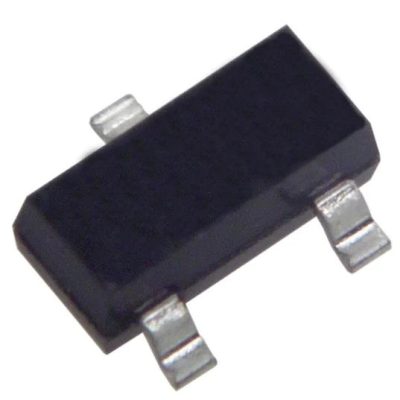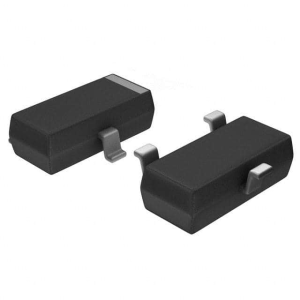BAS70-05
Part Number: BAS70-05
Manufacturer: Diodes Incorporated
Description: Schottky Diodes & Rectifiers 70V 200mW
Shipped from: Shenzhen/HK Warehouse
Stock Available: Check with us
ICRFQ.com - Electronic Components Distributor in China Since 2003

Part Number: BAS70-05
Manufacturer: Diodes Incorporated
Description: Schottky Diodes & Rectifiers 70V 200mW
Shipped from: Shenzhen/HK Warehouse
Stock Available: Check with us
| Datasheet | |
|---|---|
| Category | Discrete Semiconductor Products |
| Family | Diodes – Rectifiers – Arrays |
| Manufacturer | NXP Semiconductors |
| Series | – |
| Packaging | Tape & Reel (TR) |
| Diode Configuration | 1 Pair Common Cathode |
| Diode Type | Schottky |
| Voltage – DC Reverse (Vr) (Max) | 70V |
| Current – Average Rectified (Io) (per Diode) | 70mA (DC) |
| Voltage – Forward (Vf) (Max) @ If | 1V @ 15mA |
| Speed | Small Signal =< 200mA (Io), Any Speed |
| Reverse Recovery Time (trr) | – |
| Current – Reverse Leakage @ Vr | 10μA @ 70V |
| Mounting Type | Surface Mount |
| Package / Case | TO-236-3, SC-59, SOT-23-3 |
| Supplier Device Package | SOT-23 (TO-236AB) |
Schottky diodes are utilized since they have a low turn-on voltage, quick recovery time, and minimal energy loss at higher frequencies. Because of these properties, Schottky diodes can correct a current by facilitating a swift transition from a conducting state to a blocking state. This allows for the diodes to go from conducting to blocking quickly. As a result, Schottky diodes are frequently an excellent option for use as semiconductor devices in various settings.
The BAS70-05 is a general-purpose dual Schottky diode housed in a tiny Surface-Mounted Device (SMD) plastic packaging with the part number SOT23 (TO-236AB).
Features

In contrast to a standard PN-junction diode, made using a piece of P-type material and a part of N-type material, a Schottky Diode is built by bonding a metal electrode to an N-type semiconductor. This creates an electrical connection between the two components. Since they are made with a metal compound on one side of their junction and doped silicon on the other, Schottky diodes, do not have a depletion layer. As a result, they are categorized as unipolar devices, as opposed to the more common pn-junction diodes, which are classified as bipolar devices.
The term “Silicide,” which refers to highly conductive silicon and metal compound, is the type of contact metal utilized most frequently in fabricating Schottky diodes. This silicide metal-silicon contact has a relatively low ohmic resistance value, which enables a greater flow of current and a lesser drop in forwarding voltage of around V0.4V when conducting. The forward voltage drop produced by various metal complexes will vary, often falling between 0.3 and 0.5 volts.
Because of their rapid switching speed, long life, no contact, small size, high reliability, and widespread use in a variety of self-control circuits, communication circuits, instrumentation circuits, home computer circuits, and television circuits, Schottky diodes are utilized extensively in these applications. They are also used in video recorders, DVD players, and other electronic circuits.
Due to its construction and properties, the SBD is well-suited for high-frequency rectification in the circumstances involving high-current output and low-voltage input, as well as for detecting and mixing at extremely high frequencies. In high-speed logic circuits, it serves the function of a clamp. In addition, SBD is frequently utilized in ICs.
Schottky diodes are semiconductor devices operating at extremely high speeds while consuming little power. The most noticeable feature is that the forward voltage drop is just approximately 0.4V, and the reverse recovery time is incredibly fast (it can be as quick as a few nanoseconds). It is commonly used as a high frequency, low voltage, freewheeling, high current rectifier, and protection diode. Additionally, it is utilized in circuits such as microwave communication as a rectifier diode and a small signal detecting diode. It is more typical in power supplies and inverters used in communication systems.
In the switching circuit of the bipolar transistor BJT, you can find an example of the typical use of the Shockley diode. To boost the transistor’s switching speed, clamp it by attaching a Shockley diode to the BJT. This makes the transistor appear off when it’s on.
The forward voltage drop, also known as VF, is relatively low in Schottky diodes, their defining characteristic. When considering the same current, the forward voltage loss is significantly less. In addition to that, its time to recuperate is relatively quick. It also has several drawbacks, including a lower voltage that it can withstand and a bigger leakage current. When choosing a Schottky diode, it is essential to consider these things.
Every design engineer must choose the appropriate Schottky diode based on the application requirements they are working on. Diodes with high voltage, low to medium current, and low-frequency ratings will be needed for rectification designs. It is important for the frequency rating of the diode to be high in designs involving switching.
The following is a summary of some common and crucial parameters that pertain to diodes that you should keep in mind at all times:
Forward voltage drop: Forward voltage drop refers to the drop in voltage when a diode with a forward bias is turned on. It changes depending on the diodes that are being used. It is common to estimate that a Schottky diode’s turn-on voltage is around 0.2 V.
Reverse breakdown Voltage: The term “Reverse Breakdown Voltage” refers to the specific amount of reverse bias voltage that must be reached before the diode “breaks down” and begins conducting current in the opposite direction. The breakdown voltage for a Schottky diode in reverse is typically around 50 volts.
Reverse recovery time refers to the time it takes for the diode to transition from its forward conducting or “ON” state to its reverse working or “OFF” state. The ordinary PN-junction diode and the Schottky diode differ significantly regarding the time required for the reverse recovery. The time needed for reverse recovery in a typical PN-junction diode might range from a few microseconds to one hundred nanoseconds. Due to the absence of a depletion area at the junction, Schottky diodes do not have a recovery time. This is because of the Schottky diode’s construction.
Reverse leakage current: When subjected to a reverse bias, the current that flows out of a semiconductor device is known as reverse leakage current. When the temperature of the Schottky diode is raised, the amount of current that leaks out in the opposite direction increases noticeably.
Thank you very much for reading. We hope you have picked up some useful information from this article. If you have any questions regarding the information presented in this article, please do not hesitate to leave them in the comment sections below, and we will do our power to respond to them.
Contact us at ICRFQ, your top electronic component distributor in china, if you are interested in obtaining more information about BAS70-05 or a price estimate. We will see to it that your needs are met.
WhatsApp us